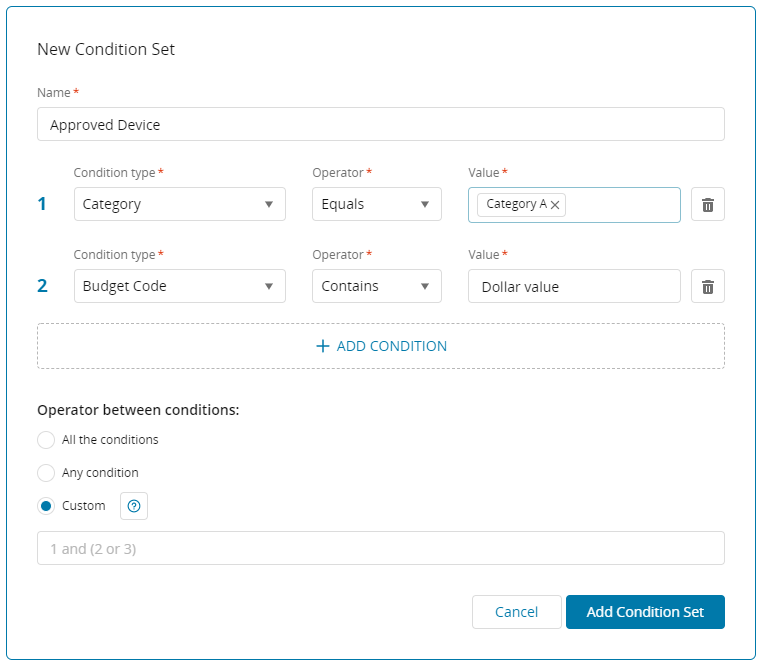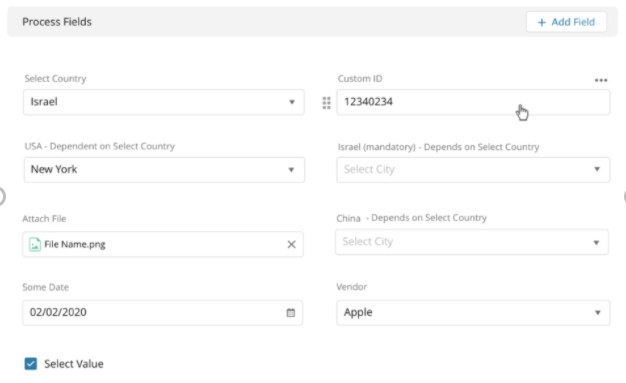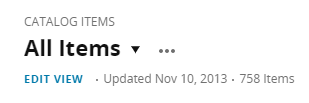What Are The Steps Involved In Building An It Service Catalog?
Service itemize
What is a service catalog?
Similar to any sales catalog that displays all the items offered in a store, your Service Catalog should be a complete, upwards-to-date list of services performed inside your organization. When customers want to request a production and/or service, your Service Catalog should exist their one-stop-store.
As the administrator, you lot will build the Service Catalog to see the specific needs of your organization. Keep in listen the following objectives:
- Provide your end-users with a single source of consequent information for communicating available services, including all associated details, interfaces, and dependencies.
- Ensure that the Service Catalog is easily accessible to users, simply implement permissions to allow only relevant users to access specific templates. Templates, or Service Requests, are pre-divers, and they provide clarity on what services are offered, how those services are offered, and expected fourth dimension frames for delivery of the services.
- Integrate with any application that provides an HTTP access indicate (with username and password hallmark) to automate processes that were previously manual. Meet more information well-nigh Process Integrations.
- Helping IT Teams benefit from having defined workflows when they provide services--workflows that are based on previous cases and building a consistent collection of information.
Service Catalog access: With the goal of e'er maintaining ease and comfort to your agents and end users, provides the power to access your Service Itemize via the platform and end users can initiate a modify straight from the Service Portal.
Benefits of your service catalog
- Saves valuable time
- Streamlines workflows
- Increases control
- Reduces operational costs
- Reduces mistakes
- Simplifies processes for end users
- Improves customer satisfaction
Prerequisites
Before you begin, make sure you can answer the post-obit questions:
- Which important services would I like to automate?
- Who needs to be involved in this process?
- What will be the stages of deployment?
- Process: What information do I demand to obtain from the stop user?
- Workflow: Which approvals are needed for the completion of a process? Are custom fields benign to ensuring all relevant details are obtained?
Every bit a last idea, consider who will use your Service Catalog:
- New users, such as:
- Administrators, who volition need detailed guidelines on how to build a service catalog.
- Users, who will need need directions on how to navigate the service catalog to locate the service request relevant to their needs.
- Seasoned users, who are familiar with the process and want quick and convenient navigation to the specific service they seek.
Building a service catalog particular
Considerations:
- Accept a moment to consider all service requests (suspension fix Incidents and/or service desk requests) your users may need regularly.
- Remember outside-the-box and consider any boosted requests that may come up due to an unexpected incident or alter.
- Notice the ability to add images and include as many custom fields to forms as necessary to quickly and accurately obtain the relevant details. This helps in limiting any back-and-forth, time consuming correspondence only to obtain details that could have been required in a predefined template.
- Include Dependent dropdowns in your template to help in data collection.
Dependent dropdowns
Dependent dropdown functionality tin lead to an array of variable types. It provides increased flexibility through the utilize of a dropdown that leads to another dropdown, free-text box, check box, or other variable that all-time fit your needs.
Based upon the devices yous offering, you tin build a variable allowing the requester to cull between a laptop, desktop, or tablet. If the user chooses a laptop, a new dropdown variable appears presenting the laptop options provided past your organisation (for example, Dell, MAC). Dropdowns ensure a fast asking workflow process.
Prerequisites for enabling the use of dependent dropdowns
To ensure smoothen continuity of services SolarWinds suggests you:
- Clone all existing catalog items for which you wish to add dependent dropdowns.
- Create changes in the copy.
- Update and test.
- If testing is successful, delete the original template to avert future use.
Instance 1: New Device Asking (Editing an existing template)
- Select the New Device Asking catalog item.
- Click the Actions push button and click Clone.
A window appears titled New Service Catalog Item with the details pre-populated from the original template. - Make the desired changes.
- Rename.
- Click Create.
Example two: New Device Request (Including Dependent Dropdowns in a template)
- Navigate to the Service Desk-bound and select Service Catalog.
- Create (if not still offered in the alphabetize page) or select (from the index folio) New Device Asking.
- In the Process Fields tab click to + Add Field.
- Observe all fields are mandatory.
Starting time define your dependent variables: Name, Field Blazon, and Values.

- Click Salvage.
- Create a new field to include the dependent variables created.
It is important to select the values from the dropdown menu.

- Click Save.
When a user creates a request for a New Device, he volition be prompted to provide all details.

Combining variable types in a dependent dropdown
You tin also combine different variables in your dropdown to give y'all a more ideal form configuration. For example, your Marketing Director could choose the type of device desired, even if it is non included in the list of devices supported past your company. To allow this:
-
Build a free-text variable, for case: Special Device Asking.
-
Become to the initial dependent dropdown and click Add together Value.
-
Select the new free-text variable you created.
Setting upward layered dependent dropdowns
To create a streamlined experience for your requesters, you can layer dependent dropdowns, thus expanding the form based on the selections made by the requester. Y'all can build as many layers as you wish. For example, get-go the user would select the type of device wanted:
- Laptop
- Tablet
- Desktop
Based upon his beginning option, the user would then be given the option to pick from another listing. In this case, if he chose Laptop from the commencement dropdown menu, the user would meet the listing of laptop devices your visitor offers:
- Dell
- Asus
- MAC
Based upon the laptop device selected by the user, he could select add-ons, such equally:
- Mouse
- Monitor
How to incorporate with your workflow processes
Yous are able to build conditional workflow processes based on both parent and child dropdown values. For example, if someone chooses an Apple device, yous may want to send tasks specifically to the team(southward) managing those devices. To achieve this, you can grouping devices together in a Condition Ready and build the specific workflow steps based upon the requester'south selections.
Editing dependent dropdowns
When editing a variable that is a Dependent Dropdown, or ane that links to a Dependent Dropdown, yous must remove all dependencies prior to making edits.
After editing your variables, build your dependencies back into your variable form.
Visualize the procedure from ticket creation to Satisfaction Survey
Before you lot begin, information technology can aid y'all to visualize the process.

Begin cosmos of a new service catalog item
-
Navigate to Service Desk-bound, and and so select Service Catalog.
SWSD takes you to the Catalog Items index page. -
Select the plus sign
 icon to create a New Service Catalog Item. Review the example below:
icon to create a New Service Catalog Item. Review the example below:

Full general details fields
All details should be requested inside the Service Request class. Yous exercise not want to waste matter your valuable time with back-and-forth correspondence betwixt requester and agent. The form should include all relevant data you would demand to collect to complete the request.
For case, if the site is not included in the form, commitment of the a new computer could exist delayed. Including the site prompts the user to provide information technology when he creates the ticket. If it is non included, valuable time can exist wasted while the agent requests the location and waits for the requester to respond.
If all needed details are required by the form and entered past the requester, and all processes are predefined, the result is a seamless asking procedure.
Tabs
Below the general details fields at that place are several tabs:
-
The Process tab. Includes all tasks and approvals required from time of request to approval. This can as well include alternative steps needed if not approved.

Directly from this tab you can make many updates to the procedure such as:
-
Chore. Update/Add a task to the process, including the name, description, and person assigned to complete job.
-
Group. Update/Add a grouping to act as a container for multiple steps to occur in a concurrent fashion.
-
Approval. Update/Add together approval steps to capture the needed authorization for a specific Change.
-
Condition Sets. Utilise a condition to whatsoever tape field (including custom fields) in a workflow. Past applying a status you enhance customization of your workflows and increase automation of processes to ensure overall efficiency.
For example:-
An onboarding workflow preparation procedure for all employees, Except for employees in the Espana office. (The Spain part provides this training in Spanish, therefore must follow a unlike workflow).
-
A workflow in which a task is added to update a specific software If the laptop model Contains the cord MacBook.
-
SolarWinds recommends review of all fields beneath to familiarize yourself with condition sets that are most relevant to your organization.

When you have multiple atmospheric condition you are able to streamline processes by selecting the specific condition type needed for this process. For case: By selecting to customize the Operator between conditions yous can select, 1 and (2 or 3) or any version necessary.
The Details tab. Provides clear visibility on items such as:- Site and Department, to be included for reporting purposes.
- Cost, for easy assay of upkeep.
- Duration, to provide visibility of process times and commitment.
In this tab, discover the ability to drag and drop the fields in the variable columns, in add-on to the ability to set default values.

The image above reflects the ability to easily arrange the lodge of the Procedure Fields by dragging and dropping them as needed, besides as to set default values.
-
-
Procedure Integration. Used to integrate with external systems.
More than information is available on using Process Integrations within your workflow procedure. -
Update Record. You tin alter whatsoever workflow process by customizing to ensure smooth automation of business processes as well every bit streamlining your workflows.
For example, you tin update any record field in the workflow, including organisation fields such equally name and/or CC. Y'all tin can select from previously cached entries.
-
Send Notifications (bachelor in Professional and Enterprise Plans). This is your automation tool to provide status updates of all processes to relevant stakeholders.
For case, for laptop requests yous can prepare an automatic notification:
- To be sent afterward a new laptop request has been denied. The notification tin can state denial with reasons why or steps on how to follow upwardly for more data.
- To be sent after a new laptop request has been approved. The notification tin can inform recipients that the laptop request has been approved and the send appointment is Xx.Xx.XXXX.
Meet Ship Notifications for more information on how to fix up e-mail templates.
After a field is updated, information technology is not available for additional updates within the same action. To brand additional changes, exit and re-enter Update Record. Also, Update Tape does non include variables (likewise known equally process fields).
- The Audit tab. Contains a predefined process within the organization. May vary across departments.
The Service Catalog index page
As you lot aggrandize your Service Itemize and create additional CIs, you can view the repository on your Service Itemize index page. As with most of your SWSD pages, this folio if fully customizable to meet your needs. The default view includes a list of All Items. Come across List View for more data on filtering, editing, and customizing your view.

After you take customized your view, there are additional options found on the meridian correct of your screen:
Visibility based on user part
The role a user is assigned in your SWSD influences visibility of tickets. Users set up as:
- Administrator or Service Agent User tin meet catalog items in whatever state.
- Service Task User or Requester can come across only canonical catalog items (through their self-service portal).
- Agent can create a CI and determine its land (for example, Draft, Internal, or Approved).
Understanding how a workflow affects a procedure
Now that y'all take finalized your workflow, it is important to understand how the procedure unfolds. Y'all can select between:
- Pre-processing: When a Change or Service Asking is submitted, the entire workflow is processed, with each stride in the workflow evaluated based on the value of weather and fields earlier the workflow begins.
- But-in-Fourth dimension processing: This option evaluates each step of the workflow based on the value of conditions and fields when these steps are reached. This allows you to base of operations workflow decisions on current value rather than values of conditions and fields prior to the workflow get-go. As a issue, you can build more than dynamic and realistic workflows that replicate your IT and concern processes.
The Audit tab provides an account of all activities related to this CI.
What is a service request?
A Service Request is any request submitted by an end user to the IT service desk with the goal of initiating a service process. When a Service Requests is received, the agent assigned is not starting from zero. The solution to standard requests are based on predefined workflows that vary in complexity. Whether simple or complex, workflows need to be standardized with a proven history to deliver services inside predefined SLAs.
Objectives to consider:
- Equally an administrator (or anyone else creating Service Catalog Items) it is important to be pro-agile and consider all the needs of the system across the teams utilizing SWSD. The Service Request is a standard service that includes pre-defined approvals and qualification processes, and clearly provides the requester with the detailed procedure he needs to follow.
Of form some Service Requests may require additional and unexpected steps that couldn't be account for when your original template was created. For instance, if someone who is part of the blessing procedure is away or a new situation arises that requires an ad-hoc solution.
When an approver is away the approver'due south status should be set to out of function.
For this reason SolarWinds provides the power to add together Ad-Hoc Tasks to open up Service Requests. (Run across the Task tab on the Service Asking folio for Ad-Hoc Tasks.) - All stop-users, both internal and external, benefit from a comprehensive Service Catalog that serves as a medium for communication. For case:
- Request for information, such as data on cloud storage limits.
- Request for access, access to a document or network.
- Request a resource, such as new phone, laptop, software, or other device.
Insert variable data
You can insert variable data into the championship of a requested service. The data submitted by your end users would then determine the title of the Service Asking, making it easier for your agents to monitor and fulfill requests. For example, when creating or editing an existing service catalog item, notice the link to Add custom championship. Here you lot tin create a service request title using variable data:
- Determine the nigh advisable championship content (you can utilize both gratis text and variable data in the championship).
- Click Add together Variable to select the desired variables.
Only Text and Dropdown Variables are bachelor for use.
- Review your title and click Save.
Utilize cases
Onboarding
By including the employee's proper noun in the ticket title, y'all can make information technology easier to differentiate between Service Requests when multiple people are being onboarded simultaneously.
Ticket Routing Automation
Past introducing variable data to the title, you can build keyword automation rules to ensure the nearly accurate ticket routing. For example, for a new computer request grade, you lot tin automobile-route a ticket to the proper squad based on the type of device selected (Mac vs Windows) by the user.
What Are The Steps Involved In Building An It Service Catalog?,
Source: https://documentation.solarwinds.com/en/success_center/swsd/content/completeguidetoswsd/service_catalog_admin.htm
Posted by: beckhamknestagave.blogspot.com


0 Response to "What Are The Steps Involved In Building An It Service Catalog?"
Post a Comment